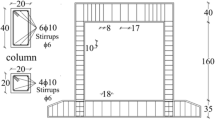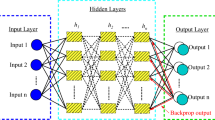Abstract
Seismic assessment of existing buildings is usually treated by international codes and guidelines through a semi-probabilistic approach based on the use of the so-called confidence factor (CF). Many authors revealed the inadequacy of such an approach, proposing alternative procedures based on: the updated calibration of the CF values together with its application to a parameter better representative of the structural response than the material strength, as usually adopted by codes; or the fully probabilistic approach by explicitly considering the propagation of uncertainties. Although the latter constitutes the most rigorous approach, it is still computationally demanding and difficult to be integrated as standard tool in the engineering practice. In this paper, the model parameter sensitivity analysis is proposed to support the seismic assessment in various aspects such as: pointing out, in an explicit way, the influence each uncertain parameter has on the structural response; supporting the set of an effective investigation plan; computing the essential parameters for a probabilistic-based verification on basis of a limited number of analyses. To the latter aim, the results from the model parameter sensitivity analysis executed according to the star design with central point approach are used to determine the median intensity measure (IMLS) and, with the help of the surface response technique, its dispersion (βLS), that are the two parameters of the fragility curve representing the capacity in the assessment. The proposed methodology is applied on two case studies, representative of existing URM buildings. Firstly, the IMLS and βLS values are calculated and thus compared, for the aim of validation, with the reference ones obtained from nonlinear static analyses performed on a large number of models generated using Monte Carlo simulations. Results obtained show a good estimate of the fragility curve parameters, compared to the rigorous probabilistic approach, highlighting the potential of the procedure proposed.















Similar content being viewed by others
References
Anthoine A, Magonette G, Magenes G (1995) Shear-compression testing and analysis of brick masonry walls. In: Duma (ed) Proceedings 10th European conference on earthquake engineering, Wien, Austria. Balkema, Rotterdam
ASCE/SEI 41-13 (2014) Seismic evaluation and retrofit of existing buildings. American Society of Civil Engineers, Reston. ISBN 978-0-7844-7791-5
Bisch P (2018) Eurocode 8. Evolution or revolution? In: Pitilakis K (eds) Recent advances in earthquake engineering in Europe. ECEE 2018. Geotechnical, geological and earthquake engineering, vol 46. Springer, Cham
Bracchi S, Rota M, Magenes G, Penna A (2016) Seismic assessment of masonry buildings accounting for limited knowledge on materials by Bayesian updating. Bull Earthq Eng 14(8):2273–2297. https://doi.org/10.1007/s10518-016-9905-8
Cattari S, Lagomarsino S (2013a) Seismic assessment of mixed masonry-reinforced concrete buildings by non-linear static analyses. Earthq Struct 4(3):241–264
Cattari S, Lagomarsino S (2013b) Masonry structures. In: Sullivan T, Calvi GM (eds) Developments in the field of displacement based seismic assessment. IUSS Press (PAVIA) and EUCENTRE, pp 151–200, ISBN: 978-88-6198-090-7
Cattari S, Lagomarsino S, Bosiljkov V, D’Ayala D (2015a) Sensitivity analysis for setting up the investigation protocol and defining proper confidence factors for masonry buildings. Bull Earthq Eng 13(1):129–151. https://doi.org/10.1007/s10518-014-9648-3
Cattari S, Lagomarsino S, Karatzetzou A, Pitilakis D (2015b) Vulnerability assessment of Hassan Bey’s Mansion in Rhodes. Bull Earthq Eng 13(1):347–368. https://doi.org/10.1007/s10518-014-9613-1
Cattari S, Camilletti D, Lagomarsino S, Bracchi S, Rota M, Penna A (2018) Masonry Italian code-conforming buildings. Part 2: nonlinear modelling and time-history analysis. J Earthq Eng. https://doi.org/10.1080/13632469.2018.1541030
CNR-DT 212/2013 (2014) Guide for the probabilistic assessment of the seismic safety of existing buildings. National Research Council, Rome
Cornell CA, Jalayer F, Hamburger RO, Foutch DA (2002) Probabilistic basis for 2000 SAC federal emergency management agency steel moment frame guidelines. J Struct Eng 128(4):526–533
Dolsek M (2009) Incremental dynamic analysis with consideration of modeling uncertainties. Earthq Eng Struct Dyn 38(6):805–825. https://doi.org/10.1002/eqe.869
EN1998-3 (2005) Eurocode 8-design of structures for earthquake resistance. Part 3: assessment and retrofitting of buildings, Brussels, Belgium
Fajfar P (2000) A non linear analysis method for performance-based seismic design. Earthq Spectra 16(3):573–591
Fragiadakis M, Vamvatsikos D (2010) Incremental dynamic analysis for estimating seismic performance sensitivity and uncertainty. Earthq Eng Struct Dyn 39(2):141–163. https://doi.org/10.1002/eqe.935
Franchin P, Pagnoni T (2018): A general model of resistance partial factors for seismic assessment and retrofit. In: Proceedings of the 16th European conference on earthquake engineering, Thessaloniki, Greece
Franchin P, Pinto PE, Pathmanathan R (2010) Confidence factor? J Earthquake Eng 14:989–1007
Franchin P, Ragni L, Rota M, Zona A (2018) Modelling uncertainties of Italian code-conforming structures for the purpose of seismic response analysis. J Earthq Eng. https://doi.org/10.1080/13632469.2018.1527262
Freeman SA (1998) Development and use of capacity spectrum method. In: Proceedings of the 6th US national conference of earthquake engineering, Seattle, USA
Haddad J, Cattari S, Lagomarsino S (2017) Preliminary and sensitivity analysis to set the investigation plan for the seismic assessment of existing buildings. In: Proceedings of the 3rd international conference on protection of historical constructions, Lisbon, Portugal
Haddad J, Cattari S, Lagomarsino S (2019) Sensitivity and preliminary analysis for the seismic assessment of Ardinghelli Palace. In: Proceedings of the 11th international conference on structural assessment of historical constructions Cuzco, Perù. RILEM Bookseries, vol 18, pp 2412–2421
Iervolino I, Spillatura A, Bazzurro P (2018) Seismic structural reliability of code-conforming Italian buildings. J Earthq Eng. https://doi.org/10.1080/13632469.2018.1540372
Jalayer F, Cornell CA (2003) A technical framework for probability-based demand and capacity factor design (DCFD) seismic format, PEER report. Pacific Earthquake Engineering Center, College of Engineering, University of California Berkeley
Jalayer F, Elefante L, Iervolino I, Manfredi G (2011) Knowledge-based performance assessment of existing RC buildings. J Earthq Eng 15:362–389
Lagomarsino S, Cattari S (2015a) PERPETUATE guidelines for seismic performance-based assessment of cultural heritage masonry structures. Bull Earthq Eng 13(1):13–47. https://doi.org/10.1007/s10518-014-9674-1
Lagomarsino S, Cattari S (2015b) Seismic performance of historical masonry structures through pushover and nonlinear dynamic analyses. Geotech Geol Earthq Eng 39:265–292. https://doi.org/10.1007/978-3-319-16964-4_11
Lagomarsino S, Penna A, Galasco A, Cattari S (2013) TREMURI program: an equivalent frame model for the nonlinear seismic analysis of masonry buildings. Eng Struct 56:1787–1799
Liel AB, Haselton CB, Deierlein GG, Baker JW (2009) Incorporating modeling uncertainties in the assessment of seismic collapse risk of buildings. Struct Saf 31(2):197–211
Mann W, Müller H (1980) Failure of shear-stressed masonry—an enlarged theory, tests and application to shear-walls. In: Proceedings of international symposium on load-bearing brickwork, London, UK, pp 1–13
Marino S, Cattari S, Lagomarsino S (2018) Use of non-linear static procedures for irregular URM buildings in literature and codes. In: Proceedings of the 16th European conference on earthquake engineering, June 18–21, Thessaloniki, Greece
MIT (2009) Ministry of Infrastructures and Transportation, Circ. C.S.Ll. pp. No. 617 2/2/2009, Istruzioni per l’applicazione delle nuove norme tecniche per le costruzioni di cui al Decreto Ministeriale 14 Gennaio 2008, G.U. S.O. n.27 of 26/2/2009, No. 47 (in Italian)
Morandi P, Albanesi L, Graziotti F, Li Piani T, Penna A, Magenes G (2018) Development of a dataset on the in-plane experimental response of URM piers with bricks and blocks. Constr Build Mater. https://doi.org/10.1016/j.conbuildmat.2018.09.070
NTC (2008) Ministerial decree 14/1/2008. Technical standards for buildings. Italian Ministry of Infrastructure and Transportation. G.U. S.O. n.30 of 4/2/2008 (in Italian)
Petry S, Beyer K (2014) Cyclic test data of six unreinforced masonry walls with different boundary conditions. Earthq Spectra. https://doi.org/10.1193/101513eqs269
Pinto PE, Giannini R, Franchin P (2004) Seismic reliability analysis of structures. IUSS Press, Pavia. ISBN 88-7358-017-3
RINTC Workgroup (2018) Results of the 2015–2017 implicit seismic risk of code-conforming structures in Italy (RINTC) project. ReLUIS-EUCENTRE report. http://www.reluis.it/
Rota M, Penna A, Magenes G (2014) A framework for the seismic assessment of existing masonry buildings accounting for different sources of uncertainty. Earthq Eng Struct Dyn 43(7):1045–1066. https://doi.org/10.1002/eqe.2386
Smerzini C, Galasso C, Iervolino I, Paolucci P (2014) Ground motion record selection based on broadband spectral compatibility. Earthq Spectra 30(4):1427–1448
Tondelli M, Rota M, Penna A, Magenes G (2012) Evaluation of uncertainties in the seismic assessment of existing masonry buildings. J Earthq Eng 16(S1):36–64
Vamvatsikos D (2013) Derivation of new SAC/FEMA performance evaluation solutions with second-order hazard approximation. Earthq Eng Struct Dyn 42(8):1171–1188. https://doi.org/10.1002/eqe.2265
Vamvatsikos D (2014) Accurate application and second-order improvement of SAC/FEMA probabilistic formats for seismic performance assessment. ASCE J Struct Eng 140(2):04013058
Vamvatsikos D, Cornell CA (2002) Incremental dynamic analysis. Earthq Eng Struct Dyn 31(3):491–514
Yun S, Hamburger RO, Cornell CA, Foutch DA (2002) Seismic performance evaluation for steel moment frames. J Struct Eng 128(4):534. https://doi.org/10.1061/(asce)0733-9445
Acknowledgements
The results were achieved in the national research project ReLUIS III 2016 (www.reluis.it), supported by the Italian Civil Protection Agency within the Research Line PS11-Treatment of uncertainties in the assessment of existing buildings (Coordinators: Proff. G.Monti and G.Quaranta). The research was accomplished in the framework of the Hermes mobility (www.hermes-mundus.com) of Jamil Haddad as a PhD student in the University of Genova, Italy.
Author information
Authors and Affiliations
Corresponding author
Rights and permissions
About this article
Cite this article
Haddad, J., Cattari, S. & Lagomarsino, S. Use of the model parameter sensitivity analysis for the probabilistic-based seismic assessment of existing buildings. Bull Earthquake Eng 17, 1983–2009 (2019). https://doi.org/10.1007/s10518-018-0520-8
Received:
Accepted:
Published:
Issue Date:
DOI: https://doi.org/10.1007/s10518-018-0520-8




